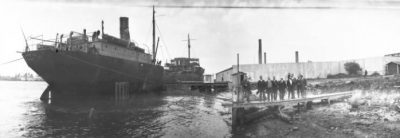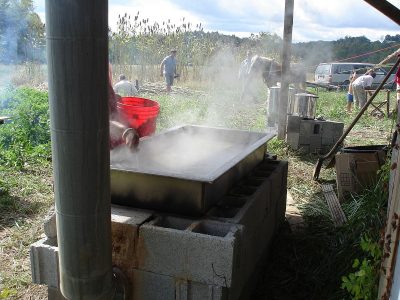
I woke up craving sweet potato biscuits, delicious enough on their own, but the vision this morning was focused on molasses. I imagined, thick ribbons of dark, smoky sweetness flowing over still-steaming butterscotch-colored biscuits.

A hundred and fifty years ago, when sugar was expensive and butter was available only if the family cow birthed a calf, assuming the family even owned a cow, coastal North Carolinians slathered molasses on biscuits.
Supporter Spotlight
Today, we buy molasses, so dark brown that it’s nearly black, in small jars for special recipes like Christmas gingerbread cookies. Afterwards, molasses gets pushed to the back of the cabinet, forgotten until the holidays return.
In the 1800s, however, molasses was North Carolina’s sweetener of choice. It took the bitter edge off collards, made grits, cornbread and popcorn taste better, and molasses was mandatory for pie, especially molasses pie, the ancestor of pecan pie.
Into the early 1900s, ships unloaded tons of molasses at the busy port of Wilmington. One 1920s photograph shows a tanker delivering a million gallons of molasses to a refinery that once existed in the area beneath what is now Cape Fear Memorial Bridge. The American Molasses Terminal accepted freighters at the foot of Queen and Wooster streets.

Early on, molasses arrived in casks. During summer’s extreme heat, the barrels had to be opened as soon as they were unloaded otherwise they would burst. The cautionary measure meant a boon for people hanging around the docks. They gathered the precious molasses drippings to take home.
Sweet as it is, molasses has a grim history.
Supporter Spotlight
From the 1600s to the early 1800s, traders sold African slaves to Caribbean sugar plantations in exchange for barrels of molasses. Ships then carried the molasses to New England, where it was turned into rum. The traders carried that rum to West Africa, where they used the liquor to barter for slaves.
The exceedingly profitable Triangular Trade made some New Englanders wealthy and convinced the British Parliament in 1733 to tax molasses imported to the colonies from the French West Indies. The tax plan helped spark the American Revolution.
Slavery continued nonetheless, and southern plantations kept great stores of molasses. In an account of her Wayne County family’s experiences during the Civil War, Harriet Cobb Lane wrote that Union troops arriving at the Cobb plantation house “rolled all the barrels filled with the year’s supply of molasses into the front hall, burst in the heads, and let the molasses run on the floor, after which they brought quantities of rice, oats, peas, meal, etc, and poured all of this on the molasses; then went up stairs, cut the featherbeds and shook the feathers down on it, and then ran horses over it, through the house.”
North Carolina knows two products referred to as molasses: blackstrap, which is the residue left from processing sugar cane into sugar, and sorghum syrup made from a cereal plant.

Sorghum, native to Africa, arrived in the New World in the 1600s and spread into the American South because the plant withstood hot summers and could be used as animal feed. Sorghum growing for syrup started in the 1800s as a cheap alternative to costly sugar.
Presses squeezed liquid from sorghum stalks, which resemble corn stalks. Boiled down, the juice became a dark brown syrup slightly thinner than molasses and possessing a sour edge as opposed to molasses’ bitterness.
As sugar became more available and affordable, especially after World War II, sorghum growers abandoned the labor-intensive syrup-making process. Home cooks traded the molasses they once said “makes everything taste better” for tiny sugar crystals that added no flavor other than sweetness and no color, thereby producing delicate cakes and cookies.
Despite the change, farmers in western North Carolina still grow sorghum and make the syrup that is often mistaken for molasses.
Molasses still shows up, albeit these days more often in fancy presentations.
Morgan’s Tavern & Grill in New Bern is known for its Molasses Chops, two 8-ounce, boneless, grilled pork chops drizzled with molasses bourbon glaze. The Peppered Cupcake in Wilmington sometimes features pork cracklings sprinkled on a sweet potato and molasses cupcake. Black garlic molasses goes with yellowfin tuna crudo at Margaux’s restaurant in Raleigh. Hole Doughnuts in Asheville serves a molasses bourbon doughnut that Bon Appetit magazine called the “best dessert” of 2016.
It all sounds delicious but not nearly as meaningful as “real biscuits” the State Farmers Market Restaurant in Raleigh serves every day with molasses.
Molasses Pie
¾ cup sugar

1 tablespoon butter, softened
3 eggs
1 cup milk
¾ cup dark molasses
1 tablespoon plain flour
1 unbaked, 9-inch pie shell
Preheat oven to 425 degrees. Combine sugar, butter, eggs, milk, molasses and flour in a large mixing bowl. Mix well. Pour into the pie shell. Bake pie for 10 minutes at 425 degrees and then lower the oven heat to 400 degrees and continue baking pie until filling is set.
Source: “Coastal Carolina Cooking” (University of North Carolina Press, 1986)








